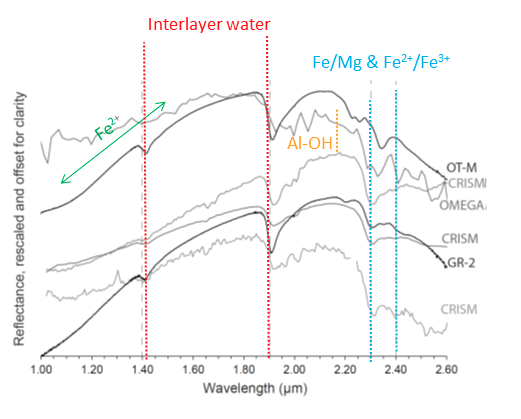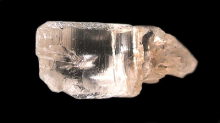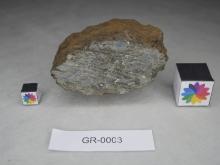Methods and results
This page presents an overview of the methods and results from the PTAL project. This page is organized following the sub-projects of PTAL below:
Laboratory Experiments and Field Analog Site Studies (WP1)
Spectral Characterization of the terrestrial field samples (WP2)
Spectral Characterization of planetary surfaces (WP3)
In addition, we wished to focus this page on a comparison between the spectral characterization of the PTAL analogue samples and data received from Mars (from orbiters, rovers and from Martian meteorites).
Assessment of Raman spectral data
The Raman spectrometers onboard the ExoMars and Mars2020 missions to Mars are the only one so far validated for space exploration mission. On one hand, the Mars 2020/Perseverance rover is equipped with a UV-Raman system (Sherloc, which configuration has been optimized for the detection of organics from proximity targets) and a time-resolved Raman spectrometer (SuperCam, equipped with a 532nm excitation source to investigate remote targets up to 5 meters distance). On the other hand, the ExoMars/Rosalind Franklin rover mounts the RLS system, which will be used to investigate powdered subsurface samples at multiple points of interest.
As no Raman data from Mars is still available to the public, no direct comparison between Martian and PTAL data could be performed. To overcome this issue, the PTAL team decided to take into consideration the Raman spectra obtained on Earth through the laboratory analysis of Martian meteorites and to combine this information with complementary analysis gathered from orbit. In detail, the PTAL team performed a bibliographic review to obtain an updated overview of the mineral compounds (both primary phases and alteration products) detected on shergottite, nakhlite and chassignite meteorites.
As the totality of the Raman spectra so far obtained from Martian rocks proceeds from the laboratory analysis of SNC meteorites, the knowledge acquired through the abovementioned bibliographic review served as a background to plan PTAL-centered laboratory studies. For example, Raman results extrapolated from Martian meteorites have been combined with complementary NIR spectra gathered from orbit (by CRISM and OMEGA systems) to evaluate the similarities of PTAL samples with well-known geological contexts on Mars. The overall result of this assessment has been partially described in Veneranda et al. (2019, Journal of Raman spectroscopy).
Using this manuscript as a starting point, the interpretation of meteoritic and orbital spectra has been further deepened. For example, a detailed bibliographic review was carried out to extrapolate the most relevant data about Martian ultramafic rocks. As reported in Veneranda et al. (2020, Nature Scientific Reports) the analysis of data from orbit confirmed that the Martian crust presents vast areas dominated by olivine and pyroxene phases. This inference about Martian crustal composition was then compared to the results obtained from the laboratory study of SNC Martian meteorites. Based on this new assessment of Martian and meteoritic data, a new research line was planned in which PTAL ultramafic analogues were used to test the capability of the RLS spectrometer to perform semi-quantitative analyses.
Following this research line, similar semi-quantification studies have been performed by taking into consideration different kinds of mineral mixtures. The main results of this work have been presented in Veneranda et al. (2021, Astrobiology), and Veneranda et al. (2021, Icarus).
In a general perspective, the reassessment of the available Martian data proved to be extremely useful to better interpret the composition of PTAL analogues, as well as to develop novel analytical procedures for spectra interpretation.
Assessment of NIR spectral data
To understand usefulness of PTAL rock collection and library data, we have performed comparative study on selected analogues and orbiter-derived data for Oxia Planum – ExoMars 2022 landing site. Oxia Planum bedrock deposits, when characterized in the near infrared by CRISM (Compact Reconnaissance Imaging Spectrometer for Mars) and OMEGA (Observatoire pour la Minéralogie, l’Eau, les Glaces et l’Activité) instruments, exhibit the characteristic absorption signal of Fe/Mg-clay minerals (minerals able to preserve traces of past life like organic molecules), potentially vermiculite or Fe-bearing saponite. Within the PTAL project, we have set out comparative analysis of two PTAL analogue rocks with NIR spectral data collected for Oxia Planum by OMEGA and CRISM. Rocks rich in Fe-rich vermiculite were taken into account, specifically 4 analogues from Granby Tuff formation and 5 analogues from Otago Conglomerate sites.
The results of this comparative study (Krzesińska et al., 2021, Astrobiology) prove that the PTAL analogues present several matches with Oxia Planum (Figure below). Knowing mineralogy of the analogue rocks (as revealed by other technique analyses: XRD and Raman), the absorption features can be understood better, and they shed light on mineralogical composition. By this, the study allows to put several constraints on evolution of Oxia Planum and transfer them into geological processes.
- Fe-rich trioctahedral vermiculite is the most likely phyllosilicate that comprises Oxia’s deposits. In terms of clay structure and its di- versus trioctahedral nature, Oxia bedrock clay-rich deposits are better matched with vermiculite-saponite mixtures in basaltic rock amygdales occurring in the Granby Tuff samples.
- Phyllosilicates at Oxia Planum are rich in Fe, mainly in the form of divalent Fe as in unoxidized Otago rocks. Preserving Fe2+ in the vermiculite structure implies limited water-rock interactions in reducing conditions during deposition of bedrock minerals.
- Both Granby and Otago samples present a more complex combination of absorptions near 2.20, 2.30 and 2.35 µm than at Oxia and present a weaker absorption near 2.39 µm. This suggests more complex mixture of clays in the Granby and Otago samples than at Oxia. Oxia displays its main absorption near 2.32 µm (sometimes associated with a weak feature near 2.20 µm) and a weaker feature near 2.39 µm. Overall, Oxia Planum clays most likely contain a less complex clay mineral assemblage than those comprising the Granby and Otago examples.
- Otago rocks are good analogues to Oxia vermiculite in terms of overall mineralogy and Fe content, but spectral inconsistencies around 2.20 µm reveal that bedrock deposits at Oxia cannot be oxidized and do not contain Al in their structure. That means limited (if any) post-alteration oxidation of Oxia deposits.
- The deposits at Oxia Planum may have been derived as ash-fall deposits (in analogy to Granby) or formed in a sedimentary setting by transport and aqueous alteration of primary minerals from elsewhere (analogy to Otago). Neither authigenic precipitation or in situ advanced pedogenic alteration of sediments are likely processes for the formation of vermiculite there.

Comparison between the NIR spectra of PTAL samples from Otago and Granby, with the phyllosilicate spectra detected from orbit at Oxia Planum (the landing site of the ExoMars rover).




